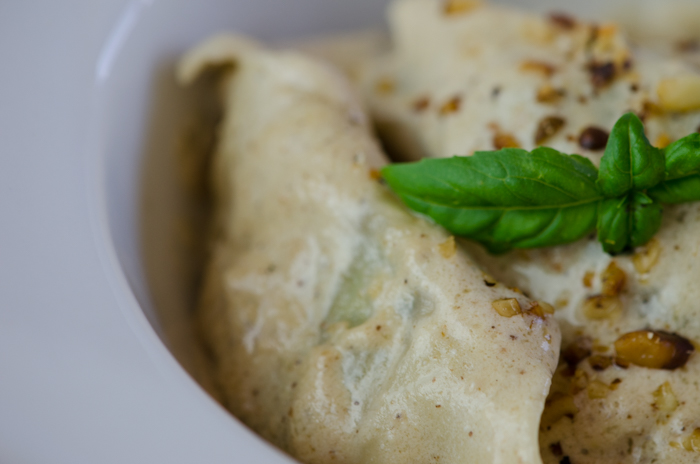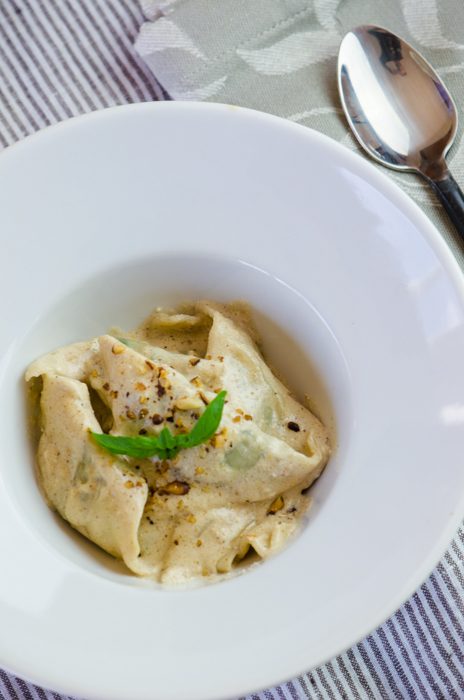 I’ve just returned from a very productive (and very enjoyable) scouting trip to Italy. We are including the Italian Riviera and Cinque Terre to our tour offerings, and are excited to share yet another wonderful Italy destination with our clients. But our research starts well before even setting foot on the ground – for me, it begins in the kitchen with learning the traditional dishes of the cuisine of Liguria.
I’ve just returned from a very productive (and very enjoyable) scouting trip to Italy. We are including the Italian Riviera and Cinque Terre to our tour offerings, and are excited to share yet another wonderful Italy destination with our clients. But our research starts well before even setting foot on the ground – for me, it begins in the kitchen with learning the traditional dishes of the cuisine of Liguria.
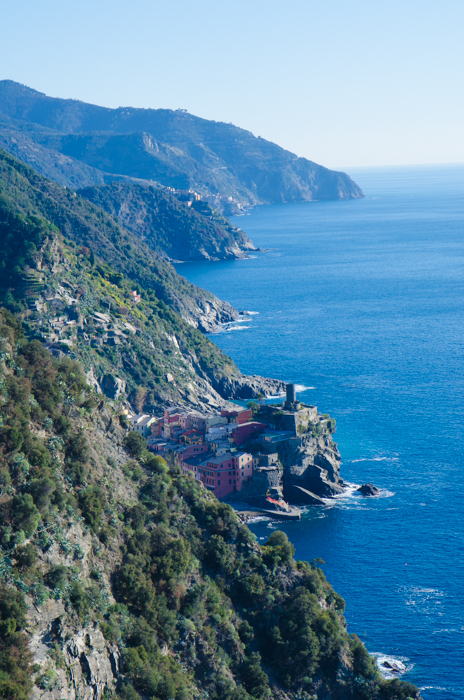 One dish that immediately caught my eye was Pansotti, a triangular ravioli stuffed with herbs, greens, and cheeses. The name Pansotti comes from the pastas pot-bellied appearance, from pancia, “belly”. Given its meat-free stuffing, it was often served during Lent or other days of abstinence.
One dish that immediately caught my eye was Pansotti, a triangular ravioli stuffed with herbs, greens, and cheeses. The name Pansotti comes from the pastas pot-bellied appearance, from pancia, “belly”. Given its meat-free stuffing, it was often served during Lent or other days of abstinence.
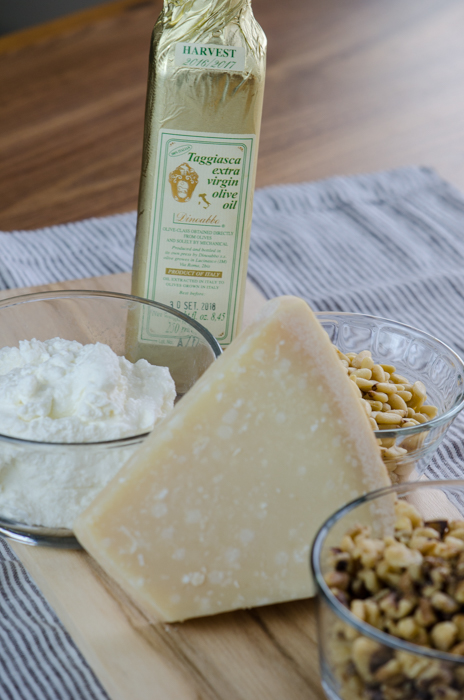 Originally the cheese used was prescinseua, a Genovese curd cheese similar to cottage cheese but more acidic. Today it is often made with a mix of ricotta and grated Parmeggiano-Reggiano.
Originally the cheese used was prescinseua, a Genovese curd cheese similar to cottage cheese but more acidic. Today it is often made with a mix of ricotta and grated Parmeggiano-Reggiano.
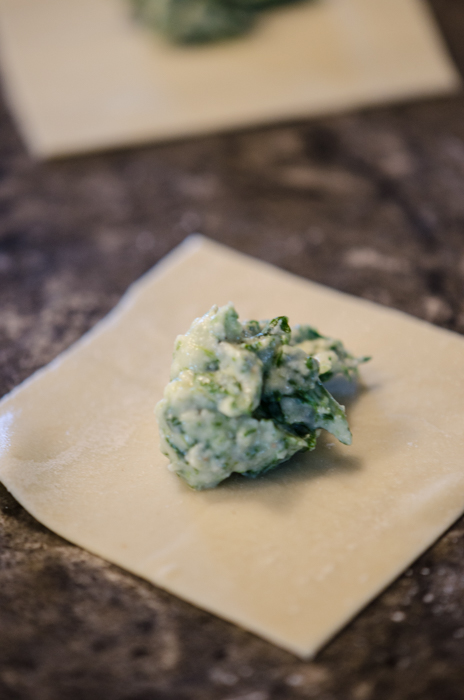 What makes these ravioli from Liguria really unique is the filling, Preboggion, a mixture of at least seven wild herbs. The name itself is believed to have originated from the term “Pro boggion”, boggion meaning bouillon or broth, indicating a mixture of different things. The mixture today will vary, and depending on the season would typically contain herbs and greens such as cabbage primaticcio (wild cabbage), Rapunzel (Campanula rapunculus, a member of the bellflower family), dandelion, parsley, nettle, borage, wild chicory, chard, chervil, burnet, and sow-thistle. As these ingredients are not commonly found in a local vegetable market, they are foraged.
What makes these ravioli from Liguria really unique is the filling, Preboggion, a mixture of at least seven wild herbs. The name itself is believed to have originated from the term “Pro boggion”, boggion meaning bouillon or broth, indicating a mixture of different things. The mixture today will vary, and depending on the season would typically contain herbs and greens such as cabbage primaticcio (wild cabbage), Rapunzel (Campanula rapunculus, a member of the bellflower family), dandelion, parsley, nettle, borage, wild chicory, chard, chervil, burnet, and sow-thistle. As these ingredients are not commonly found in a local vegetable market, they are foraged.
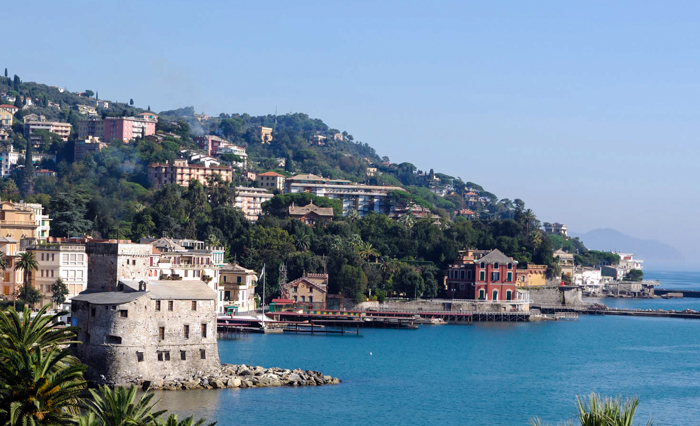 We visit the town of Rapallo on our tours, a port city on the Tigullio Gulf. From the 16th-century Castello sul Mare (Castle-on-the-Sea) to the cable car to Nostra Signora di Montallegro (Our Lady of Montallegro), offering stunning panoramic views, to nearby destinations like Portofino and Camogli we have plenty to explore here. This is also the perfect destination to try the authentic Pansotti in Salsa di Noci – walnut sauce. A few local restaurants are officially recognized by the Rapallo De.CO., the Consorzio Pansotto Rapallo, a consortium dedicated to the preservation of this traditional specialty. While the following recipe would not be up to their standards, it was still delicious!
We visit the town of Rapallo on our tours, a port city on the Tigullio Gulf. From the 16th-century Castello sul Mare (Castle-on-the-Sea) to the cable car to Nostra Signora di Montallegro (Our Lady of Montallegro), offering stunning panoramic views, to nearby destinations like Portofino and Camogli we have plenty to explore here. This is also the perfect destination to try the authentic Pansotti in Salsa di Noci – walnut sauce. A few local restaurants are officially recognized by the Rapallo De.CO., the Consorzio Pansotto Rapallo, a consortium dedicated to the preservation of this traditional specialty. While the following recipe would not be up to their standards, it was still delicious!
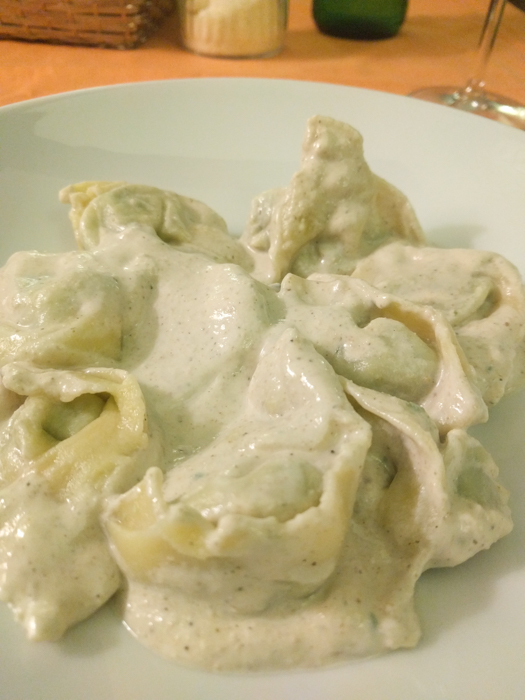 Pansotti al Preboggion con Salsa di Noci
Pansotti al Preboggion con Salsa di Noci
Ligurians often use white wine in their pasta, which results in a very delicate pasta, perfect for these ravioli, so you may want to roll it a bit thicker than usual.
For the dough
3 cups all purpose flour
1 1/2 teaspoons salt
1/4 cup dry white wine
1/3 to 1/2 cup water
1 large egg
For the filling
1/2 pound mixed herbs and baby greens
3/4 cup grated Parmeggiano-Reggiano
1 clove garlic, minced
3/4 cup ricotta
1/4 teaspoon nutmeg
1 large egg
Kosher salt and freshly ground pepper
For the sauce
3/4 cup walnuts
1/4 cup pine nuts
1 clove garlic
1/4 cup grated Parmigiano-Reggiano
1/3 cup extra virgin olive oil
1/2 cup fresh ricotta
Kosher salt and freshly ground pepper
1/4 cup heavy cream
To make the dough:
Place the flour on your counter in a mound. Make a well in the middle. Place the salt, wine, 1/3 cup water and egg in the well. Using a fork, lightly beat the ingredients in the well. Gradually start incorporating the flour from the sides of the well. Eventually the sides of the well will collapse, at this point use a pastry scraper to work the rest of the flour into the dough. if the dough doesn’t come together after a few minutes, add the rest of the water.
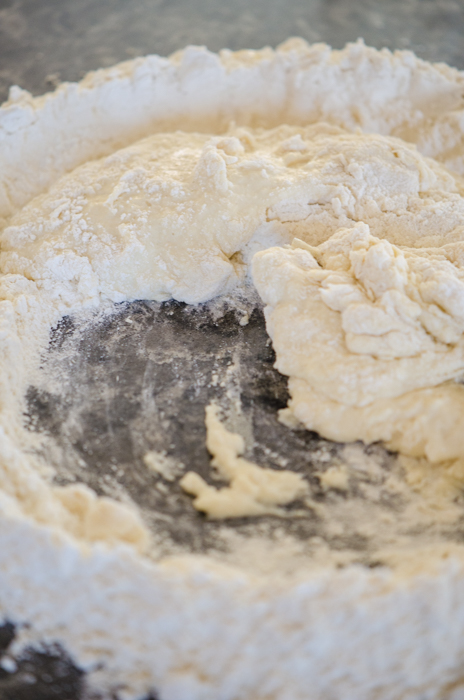
Knead the dough for about 15 minutes, working a bit more flour into it when it gets a bit sticky. The dough should be very smooth, silky, and very elastic.
To roll out the pasta using a pasta machine, divide the dough into 4 – 6 pieces. You will roll out one piece at a time, while rolling keep the remainder covered with plastic wrap so it does not dry out. Lightly flour the machine rollers, the work surface around the machine, and the first piece of dough. Set the rollers at the widest setting. Flatten the dough into a disc, sprinkle with flour, then feed the disc into the space between the two rollers. Feed the dough through with one hand, while holding the upturned palm of your hand under the sheet emerging from the rollers. Keep your palm flat to protect the dough from punctures by your fingers.
As the sheet emerges from the rollers, guide it away from the machine with your palm. Pass the dough through the rollers five to six times, folding it into thirds and flouring it each time. Then set the rollers at the next narrower setting and pass the dough through three times, folding it in half each time. Repeat, passing it through three times at each successively narrower setting. Repeated stretching and thinning builds up elasticity making especially light pasta. If the sheet becomes too long to handle comfortably, cut it in half or thirds and work the pieces in tandem.
Don’t worry if at first the dough tears, has holes, is lumpy, or is very moist. Just lightly flour it by pulling the dough over the floured work surface. Take care not to overdo the flouring, or the dough may get too stiff. As you keep putting it through the rollers, it will be transformed from slightly lumpy and possibly torn to a smooth, satiny sheet with fine elasticity.
Different machines have different numbers of settings. These ravioli use the thinnest setting on a machine, which will be thin enough for you to see color and shape through it; this is perfect for lasagna and filled pastas. If it is so thin that the dough tears easily, however, stop at the next to last setting.
Place the pasta sheets on a floured sheet pan, separated by deli paper or plastic wrap. Cover the pile with a slightly damp towel.
Prepare the filling:
Bring a large pot of water to a boil and blanch the herbs and greens for 3 minutes. Drain, and submerge in ice water, and squeeze out the excess water.
Finely chop the blanched greens in a food processor or with a knife. Transfer them to a bowl and add the cheese, garlic, ricotta, and nutmeg. Season with salt and pepper. Add the egg and mix well to combine.
Prepare the Pansotti
Cut the dough into four pieces and cover three of them with plastic wrap. Run the remaining piece through the widest setting of an pasta machine. You should obtain a thick, flat slice of dough. Fold into thirds, then put it back through the machine from its shortest side at the same setting. Repeat this process at least 3 times. Then start running the dough through at progressively narrower settings until you reach the very last one, always flouring both sides of the dough and inserting the shortest side first. Set the resulting long sheet of dough aside on a lightly floured surface, and cover it with a kitchen towel to keep it moist. Repeat with the other three pieces of dough. This dough is very delicate and can be a bit sticky. Make sure you dust all surfaces generously with flour when working with it.
With a dough cutter or knife, cut all the dough sheets in half lengthwise. Then, from each sheet, cut out squares about 3 inches across. Spoon about 1 teaspoon of the filling at the center of each square and fold it in half to form a triangle, sealing two of the sides with a quick brush of water. Continue filling and folding until you run out of dough and filling. You can leave the triangles as is, or take the two corners on the fold and pinch them together to form a tortellini type shape. I’ve seen Pansotti done both ways, in Rapallo the corners were pinched, which to me looks more like a “belly”.
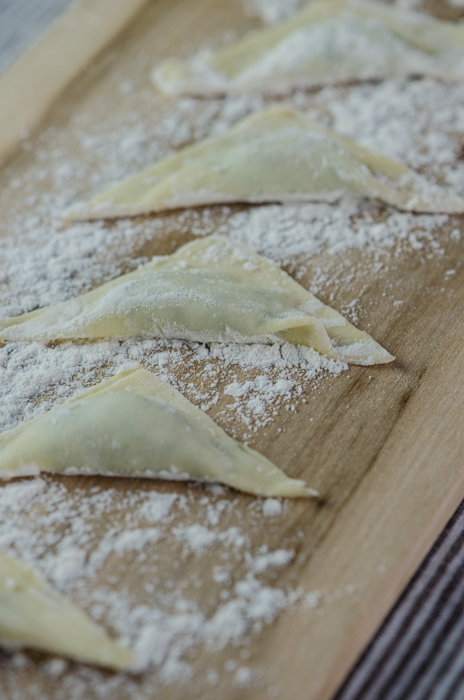
Arrange the pansotti in a single layer on a lightly floured surface and cover them with a kitchen towel. You can freeze them at this point, if you are not planning to use them right away.
Prepare the sauce
Toast the walnuts, and allow to cool. Place the cooled walnuts, pine nuts, garlic and Parmigiano in the bowl of a food processof and puree until creamy, about 2 minutes. With the food processor running, add the olive oil in a thin stream and continue to process until a smooth creamy sauce forms. Transfer to a bowl and add the ricotta, mixing with a spoon to incorporate it into the sauce. The mixture should be smooth but fairly dense. Add salt and pepper to taste.
Bring a large pot of generously salted water to a boil. Cook the pansotti for 4 to 5 minutes, or until they’re soft and pliable.
Meanwhile, transfer the sauce to a 12-inch skillet, add the heavy cream and stir to incorporate over medium-low heat, 2 to 3 minutes. Adjust seasoning.
Drain the pansotti, reserving 1/2 cup of the cooking water, and toss them with the sauce. If the sauce seems too dry, add the cooking water 1 or 2 tablespoons at a time. Serve immediately.
